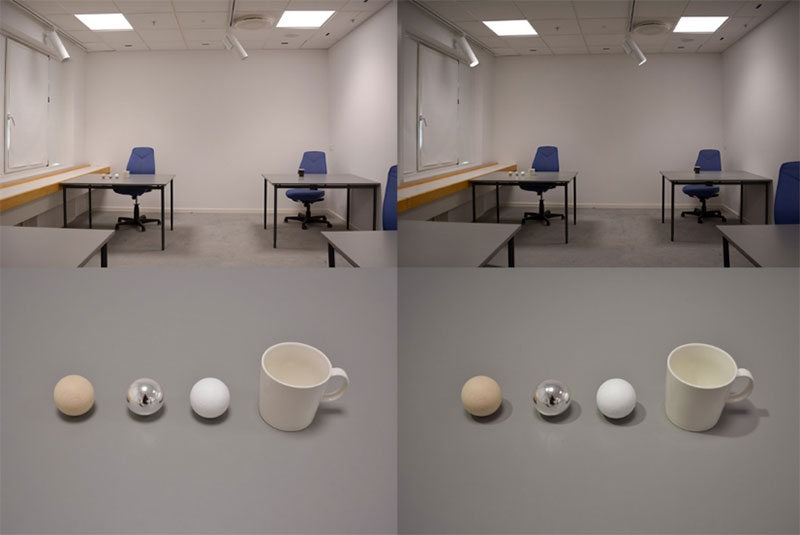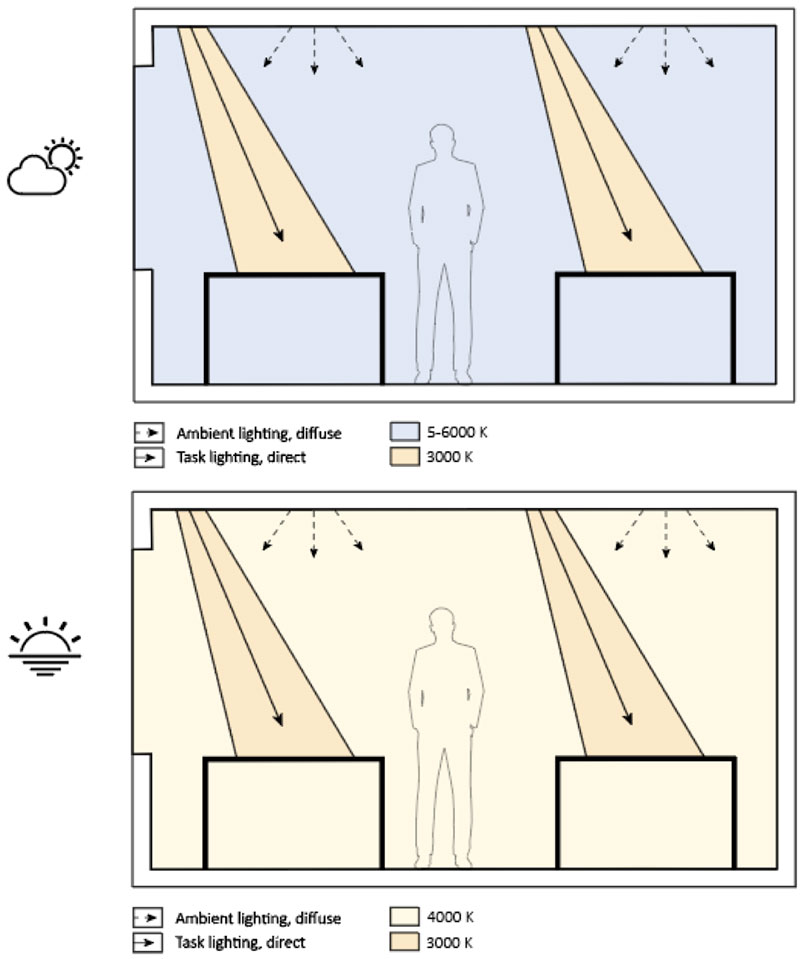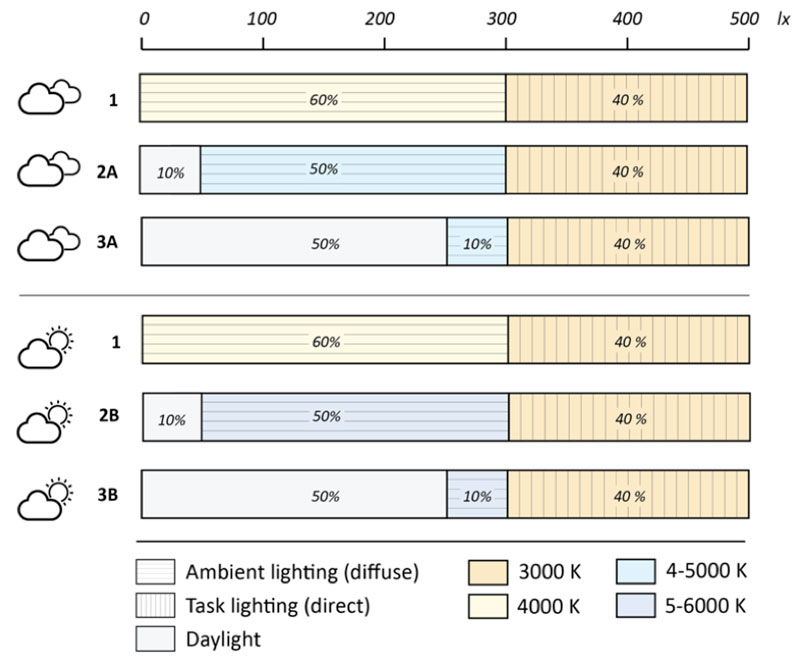Editorial Disclaimer
The views expressed in articles published on FIRES do not necessarily reflect those of IES or represent endorsement by the IES.
Authors: Ellen Kathrine Hansen, Mihkel Pajuste; Aalborg University, Copenhagen
Concept
In this new dynamic lighting approach, the sky type and daylight inflow are taken into consideration actively, bringing the dynamic office lighting to life instead of only meeting the static illuminance requirement through artificial lighting. The daylight components, direct warm sunlight and diffuse cool sky light, are the main source of inspiration for working with a unique combination of dynamic interactions between directional task lighting and diffuse ambient lighting, with respective intensities and colour temperatures, to create naturally perceived luminous variations in the office environment.
Since 2017, the lighting technology and solution partners Tridonic, iGuzzini, Fagerhult and Zumtobel have teamed up with Aalborg University to develop and scientifically validate the ambitious “double dynamic lighting” (DDL) concept.
This new lighting design concept of dynamic indoor lighting for office environments demonstrates how advanced responsive lighting technology can bring the office lighting to life by bringing the qualities of natural light into the office and thereby improve the indoor lighting environment and work engagement. The double dynamic lighting is embracing the dynamic qualities of daylight, referring to multisensory human perception of unpredictability, naturalness, flow of light, light modelling effect and personal light zones.
Studies
In a pre-study, the direct and diffuse lighting components were investigated for creating and enhancing visual qualities such as flow of light, extending the natural flow of daylight in space; light modelling effect, creating shadow patterns and highlights to emphasize the three-dimensionality of objects on work planes; and light zones, creating personalized working islands for the users. (See Research Paper 1.)
Thereafter, two pilot experiments were conducted at Aalborg University in Copenhagen to investigate and define: a) a specific ratio of direct:diffuse lighting for creating the aforementioned lighting qualities; and b) correlated colour temperatures (CCTs) of the direct:diffuse lighting components, contributing to the perceived work atmosphere under clear sky and overcast sky conditions. (See Figures 1 and 2 and references to Research Papers 2 and 3.


In the last stage of the project, a field experiment with seven different light settings were implemented in an office environment in Copenhagen, with four participants working there over a four-month period. The effect on the perceived atmosphere, visual comfort and work engagement were compared to static lighting. Advanced lighting technology was utilized, using live sky-scanner data and illuminance sensors to determine the sky condition and application of the designed lighting settings, depending on illuminance levels and the sky type. (See Research Paper 4.) The convergent parallel mixed method approach with interviews and questionnaires revealed several findings in favor of double dynamic lighting, in comparison to static lighting.
Results
The results of the field study demonstrated that it is possible to define dynamic light settings responding to the dynamics of daylight through a combination of direct and diffuse lighting. DDL was validated to have a positive impact on perceived atmosphere, visual comfort, and work engagement compared to static lighting. In general, it was confirmed that the combination of directional task lighting and diffuse ambient lighting, responding to sky types and measured daylight level in the space was favored compared to static standard diffuse lighting.
The perceived atmosphere was found to be more pleasant. The DDL concept, with a mixture of direct and diffuse warm, neutral, and cool colour temperature, was described and characterized with several references to naturalness of lighting and daylight components by the participants in the interviews. The interviews have proven valuable data and examples of subjective experience of the double dynamic lighting.
Quotes from interviews about the perceived atmosphere after a dynamic lighting test period:
“I feel like when it’s overcast and the sun isn’t that much out; the lighting is kind of more comforting in the room, because it fills more.”
“I noticed the light in the room, but it feels like the daylight and the light in the room are blended together, in a way. So, the weather is like casted into the room, projected.”
“And then, at some point during the daytime, I don’t notice the lighting at all, and it feels very natural. It’s just there complementing the space and task.”
Quote from an interview after a static test period:
The analysis of the interviews revealed a large difference in the perceived visual comfort between the dynamic and static lighting periods within the same season. The DDL lighting was evaluated with 83% positive statements in October, whereas only 35% of the statements were positive with static lighting in November. Therefore, it is indicated that working with light zones as with direct and diffuse lighting components and uneven light distribution, enable a high visual comfort for the participants, still meeting 500 lux on the task area.
From the analysis of the weekly questionnaires, the most positive effect was found in evaluating work engagement thereunder, with an impact for motivation, concentration, and workflow. In the questionnaire, six questions were designated for evaluating work engagement. The participants were asked to evaluate the frequency on a scale 1 to 5 (never – rarely – occasionally – frequently – very frequently). For instance, “During this week my work performance has been good.” In October, clear positive indications could be detected. Five out of six questions were ranked significantly higher (10% to 15%) as compared to static lighting. Moreover, it can be argued that a larger diversity of exposure to different light settings was found to contribute positively to work engagement. To gain a more in-depth understanding of the impact of the double dynamic lighting in relation to season and the specific office space, Research Paper 4 is recommended.
Design Recommendations for DDL
Based on the findings from the DDL experiments and field study, the following design recommendations have been suggested:
Dynamics
- Use of intelligent sky and light sensors to respond to daylight inflow and sky variations.
- Detection of two main sky variations: 1) overcast; and 2) clear sky.
- Three daylight levels on task area: 1) less than 50 lx during dark and transition hours; 2) 50 to 250 lx primary for morning and evening hours; and 3) 250 to 550 lx general daytime hours. With more than 550 lx, the electrical lighting switches off as daylight is sufficient.
Direct/diffuse lighting components
- Directional lighting with approximately 30-degree tilt angle, referring to daylight inflow from side windows, to create a flow of light and enhance the naturalness of luminous environment.
- Combination of direct and diffuse light sources, with a ratio of 20% to 40% from directional lighting, to create the light modelling effect and personalized light zones.
Colour (CCT)
- Direct light source of 3000 K (warm), referring to the warm sunlight as a standard. (See Figures 3 and 4.)
- Diffuse light source, representing the ambient lighting with different colour temperatures. For overcast, 4000 to 5000 K (neutral), and for clear sky 5000 to 6000 K (cooler), to contribute to perceived atmosphere. (See Figures 3 and 4.)


Light levels
- Light levels of 500 lx minimum on the task area and 300 lx in the space, meeting the EN 12464 standard.
- However, the direct light source is proposed to be personalized to meet the users’ needs best, with adjustable intensity and CCT, due to the variation in meeting visual comfort or perceived atmosphere.
The aim of these generalized guidelines is to act as inspiration for future designs and developments of the dynamic lighting potentials and thereby support the indoor environment to meet human needs for natural variations.
The guidelines are based on the specific context and can be adjusted to different spatial, functional and geographic context.
Future Work
Numerous future works are proposed to extend the potentials of the double dynamic lighting concept. First, investigation of the effect of the DDL settings following time of day and adding the non-visual effect of stimulating circadian rhythms. Second, studies exploring dynamic sunscreen adaptation for a holistic control of luminous conditions are proposed. The appropriate light level and distribution in the individual workspace to meet individual needs, enabling the electricity used for lighting in larger office spaces to be reduced to what is needed for individual task lighting and ambient lighting. And last, the accuracy and usage of data input—for instance, from local weather stations—is recommended for future case studies implementing this weather responsive concept.
Research Papers
Research Paper 1:
Hansen EK, Mathiasen N. Dynamic lighting balancing diffuse and direct light. In ARCH19: Building for better health 2020. Polyteknisk Boghandel og Forlag.
Research Paper 2:
Hansen EK, Stoffer S, Xylakis E, Pajuste M. Dynamic lighting in office environments creating a natural flow of light. 2019. Professional Lighting Design Convention, Rotterdam October 23-26th 2019.
Research Paper 3:
Hansen EK, Pajuste M, Xylakis E. Flow of light: balancing directionality and CCT in the office environment. LEUKOS; 2020. Online: https://www.tandfonline.com/doi/full/10.1080/15502724.2020.1808014. (Accessed 2021 Feb 22).
Research Paper 4:
Hansen EK, Bjørner T, Pajuste M, Xylakis E. A field experiment of double dynamic lighting in an office responding to sky and daylight: Perceived effects on comfort, atmosphere, and work engagement. Indoor and Built Environment 2021. Online: https://journals.sagepub.com/doi/10.1177/1420326X21991198. (Accessed 2021 Feb 22).
Partners
Industrial partners:
Tridonic
Saurabh Madan, Industrial Project Manager, Global Application Marketing Manager
Jan Schrottenholzer, Segment Manager, Office, Education & Industry
Fagerhult
Henrik Clausen, Director of Fagerhult Lighting Academy
iGuzzini
Peter Roos, Product & Project-Solutions Director
Laura Cinquarla, Knowledge Network Manager
Zumtobel
Daniel Lechner, Director Brand Management, Zumtobel & Services
University partner:
Aalborg University, Copenhagen
Ellen Kathrine Hansen, Research Project Manager, Head of Lighting Design Research, PhD., Associate Professor
Mihkel Pajuste, Research Assistant, MSc in Lighting Design
